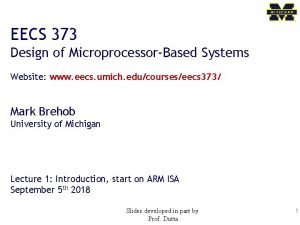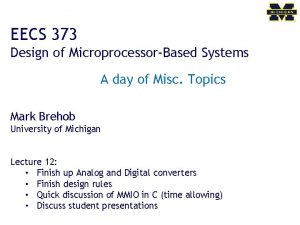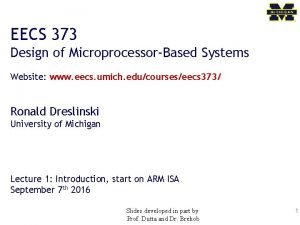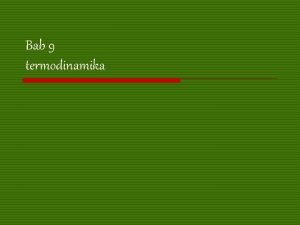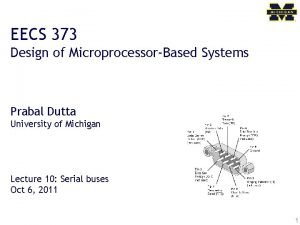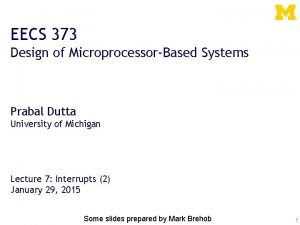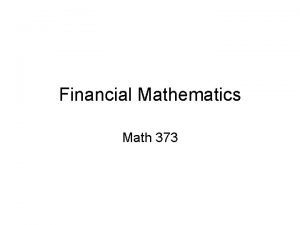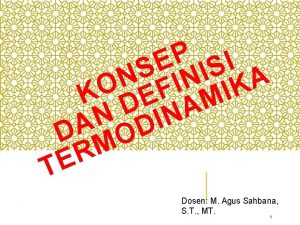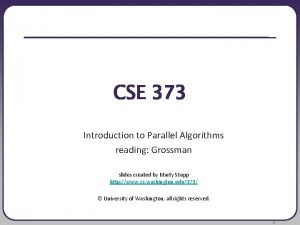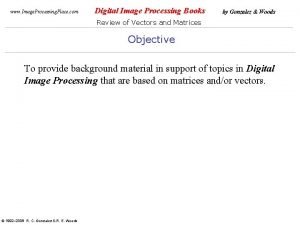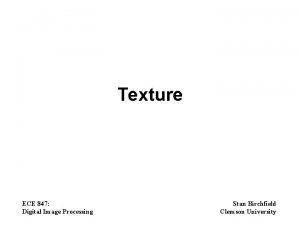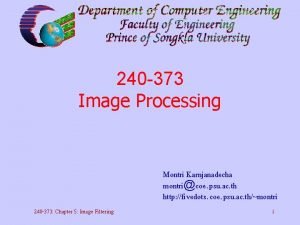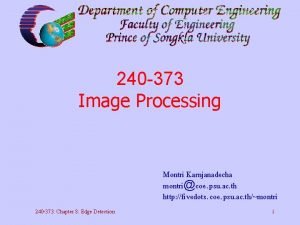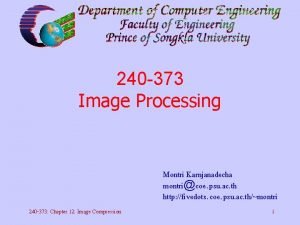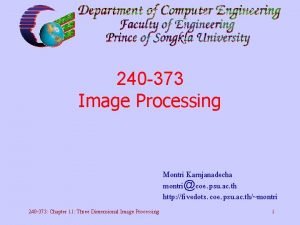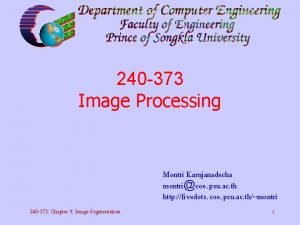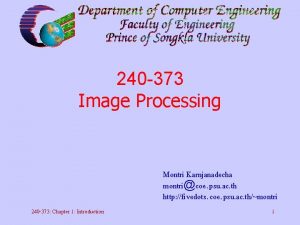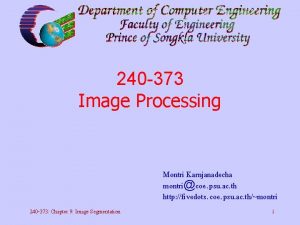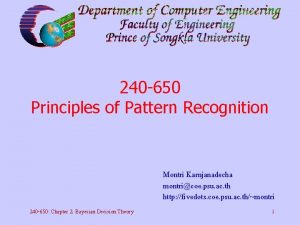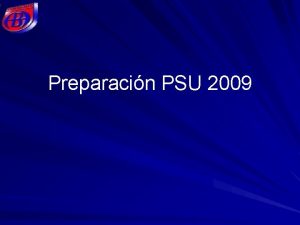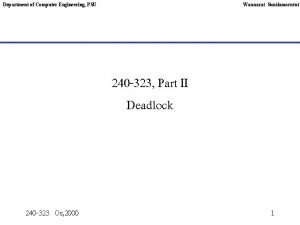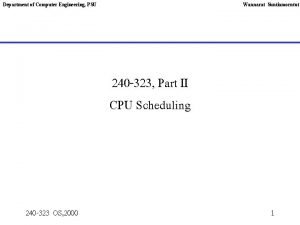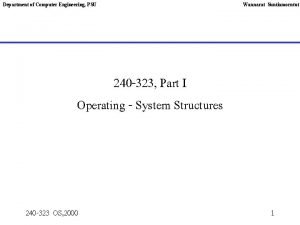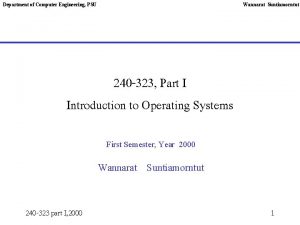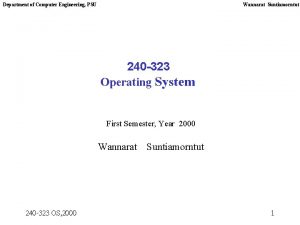240 373 Image Processing Montri Karnjanadecha montricoe psu





































- Slides: 37

240 -373 Image Processing Montri Karnjanadecha montri@coe. psu. ac. th http: //fivedots. coe. psu. ac. th/~montri 240 -373: Chapter 6: Morphological Image Processing 1

Chapter 6 Morphological Image Processing 240 -373: Chapter 6: Morphological Image Processing 2

Morphological and Other Area Operations • Introduction – Morphology is the science of form and structure – It is about regions or shapes, in computer vision • Morphology can be used for the following tasks: – Smoothing the edges of a region – Forcing shapes onto region edges – Counting regions – Estimating sizes of regions 240 -373: Chapter 6: Morphological Image Processing 3

Morphological Operations • Morphological operations are easily seen on binary images but they can be extended to work on graylevel images • Basic Morphological Operations – Consider the following image 1 * 1 * 1 – This could be represented as a set of those pixels in 5 x 3 image that have value ‘ 1’, namely {(2, 4) , (2, 2) , (2, 0) , (1, 3) , (1, 1) , (0, 4) , (0, 2) , (0, 0)} 240 -373: Chapter 6: Morphological Image Processing 4

Morphological Operations • And now it is possible to do set operations on images 1 1 * * *1 * 1 A=* 1 * B= * * * 1 1 * * *1 * 1 Giving 1 **** A union B = * 1 1, 1 **** 1 1 1 * 1 A intersection B = * * * 1* 1 1 1 * 1 240 -373: Chapter 6: Morphological Image Processing 5

Morphological Operations • The set on unknown pixels (*) can, theoretically, extend infinitely * * * * * * * * * 1 * * * * * 1 1 * * * * * * * * * * * * where the circle around the top left 1 indicates the position of the origin 240 -373: Chapter 6: Morphological Image Processing 6

Dilation Technique 1: Dilation (Minkowski addition( USE: Region edge valley filling (for binary image( OPERATION : – A template (made from 1’s and *’s) is created with a known origin – The origin of this template is stepped over every element in the whole of the image 240 -373: Chapter 6: Morphological Image Processing 7

Dilation OPERATION: (cont’d ( – The template is ‘unioned’ where the origin of the template corresponds to a 1 in the image – The resulting template-sized matrix is then unioned with all other template-sized results (using their original position( 240 -373: Chapter 6: Morphological Image Processing 8

Dilation Example Image Template Applying the template to the first line gives 240 -373: Chapter 6: Morphological Image Processing 9

Dilation Example Application across the whole image gives new row new column – Continually applying this to the images fills out all the holes and makes the image grow, one row and one column at a time 240 -373: Chapter 6: Morphological Image Processing 10

Erosion Technique 2: Erosion (Minkowski subtraction( USE: To remove spikes from the edges of regions OPERATION : – A template is created – The template is stepped over the image but it is not allowed to go outside the image – For every position, if the template is the same as the image window, then the element corresponding to the origin of the template is set to a 1 240 -373: Chapter 6: Morphological Image Processing 11

Erosion Example Image 240 -373: Chapter 6: Morphological Image Processing Template 12

Erosion Example • Final result is unused row and column 240 -373: Chapter 6: Morphological Image Processing 13

Gray-level Erosion and Dilation Technique 3: Gray-level erosion and dilation USE: Flattening spikes and filling valleys on region edges in gray-level images OPERATION : – Let I(x, y) be an image of gray levels and R(x, y) be resulting image after I(x, y) has been dilated/eroded with m x n template T(i, j( => 0 i <= m-1, 0 <= j <= n-1 240 -373: Chapter 6: Morphological Image Processing 14

Gray-level Erosion and Dilation OPERATION : – Gray level dilation is defined as – and gray level erosion is 240 -373: Chapter 6: Morphological Image Processing 15

Gray-level Erosion and Dilation NOTES : – For both of the above definitions, I(x, y) = 0 for locations outside of an M x N image – Dilation is precisely the dual of the erosion operation. A dilation can be performed by reflecting the template and negating the original image and then negating the result. 240 -373: Chapter 6: Morphological Image Processing 16

Example Consider the following initial image Dilating by the template 240 -373: Chapter 6: Morphological Image Processing 17

Example gives or subtracting 1 throughout 240 -373: Chapter 6: Morphological Image Processing 18

Example Conversely, erode by the same template gives 240 -373: Chapter 6: Morphological Image Processing 19

Example or if 1 is subtracted throughout 240 -373: Chapter 6: Morphological Image Processing 20

Example NOTE : – Dilation gives a larger image, while erosion gives a smaller image – In both cases, the original structure of the image is maintained – If the template is not constant, say 240 -373: Chapter 6: Morphological Image Processing 21

Example the results are as follows: Original • D(E(D(I))) = D(I) Dilate -1 and 240 -373: Chapter 6: Morphological Image Processing Erode + 1 E(D(E(I))) = E(I( 22

Opening and Closing Operations • OPENING = dilating after eroding • CLOSING = eroding after dilating Technique 4: Opening and closing operations USE: As a step towards the skeleton, counting, and size-estimating operations below 240 -373: Chapter 6: Morphological Image Processing 23

Opening and Closing Operations OPERATION: – Let OPEN(I, T) be the opening of image I by some template T – Then using previous terminology and the template T throughout OPEN(I, T) = D(E(I(( This gives 240 -373: Chapter 6: Morphological Image Processing 24

Opening and Closing Operations Original Opened with Clearly, this restores the image to its original and avoids the scaling of the result. It introduces the shaping of the template into the original. 240 -373: Chapter 6: Morphological Image Processing 25

More interesting is its operation on clear edges Original Opened with Note how the peak (1 1 2 5 5 4) has been smoothed to the shape of the template but that the trough (1 3) has been left alone. 240 -373: Chapter 6: Morphological Image Processing 26

Closing is defined as CLOSE(I, T’) = E(D(I(( with E and D using T’ where T’ is the 180 o rotation of T Original Closed with Now the trough has been filled but the peak has been left. 240 -373: Chapter 6: Morphological Image Processing 27

Properties of open and close operations • OPEN -> forces the shape of the template on the convex parts of an edge • CLOSE -> forces its shape on the concave parts of an edge • These two operations can be combined to produce a skeleton operation 240 -373: Chapter 6: Morphological Image Processing 28

Skeleton Operations Technique 5: Skeleton operations USE: To create a skeleton of a region. This will consist of a set of lines corresponding to complete thinning of the region without losing the essential shape. 240 -373: Chapter 6: Morphological Image Processing 29

Skeleton Operations OPERATION : – Let D 1, D 2, …, Dn be structuring templates that are square, with sizes 1 x 1, 2 x 2, …, n x n, all of them filled with 1’s. – With image I, using template D 1, D 2, …, Dn, in turn, evaluate resulti = E(I) - OPEN(E(I(( – Then determine 240 -373: Chapter 6: Morphological Image Processing 30

Skeleton Operations Example: Original Final image using only D 1, D 2, D 3, and D 4 • This corresponds to a skeleton of the image, retaining length but reduce thickness 240 -373: Chapter 6: Morphological Image Processing 31

Granule sizing and granule counting Technique 6: Granule sizing and granule counting USE: To estimate the number of bright regions in an image. To estimate the size of the regions in an image. 240 -373: Chapter 6: Morphological Image Processing 32

Granule sizing and granule counting OPERATION : – Using templates such as a set of vertical or horizontal 1’s with increasing length to estimate the size of the area – Using vertical or horizontal templates with binary strings having values 2 n + 1 (i. e. 1, 101, 10001, etc. ) to count the number of areas – In both cases, the image is eroded by the structuring templates and a measure of how many elements are now non-zero, or a sum of the power in the system is calculated – The number is plotted against the template structure length to give a covariance curve whose peaks indicate the size and number of granules (areas) in the image. 240 -373: Chapter 6: Morphological Image Processing 33

Example • The following image was eroded with the templates as shown below. After each erosion the number of pixels > 0 was counted and the power of the resulting image was summed. Original image 240 -373: Chapter 6: Morphological Image Processing 34

Example Length Type of string 11…. 1 power 2063 11312 48483 22114 33005 776 777 448 119 0010 count 10… 01 power count 1 240 -373: Chapter 6: Morphological Image Processing 35

Example Given a slightly altered image 240 -373: Chapter 6: Morphological Image Processing 36

Example which eroded with 10… 01 pattern gives length 9 8 7 6 5 4 3 2 1 count 30 21 13 9 10 11 9 5 1 power 87 52 25 14 15 15 12 6 1 240 -373: Chapter 6: Morphological Image Processing 37
 Neighborhood processing in digital image processing
Neighborhood processing in digital image processing Image enhancement by point processing
Image enhancement by point processing Histogram processing in digital image processing
Histogram processing in digital image processing Neighborhood processing in digital image processing
Neighborhood processing in digital image processing Point processing in image processing
Point processing in image processing Digital image processing
Digital image processing Image transform in digital image processing
Image transform in digital image processing Optimum notch filter in image processing
Optimum notch filter in image processing Compression in digital image processing
Compression in digital image processing Key stages in digital image processing
Key stages in digital image processing Error free compression in digital image processing
Error free compression in digital image processing Image sharpening in digital image processing
Image sharpening in digital image processing Geometric transformation in digital image processing
Geometric transformation in digital image processing False contouring
False contouring Image transforms in digital image processing
Image transforms in digital image processing Maketform matlab
Maketform matlab Noise
Noise Umich eecs 373
Umich eecs 373 Eecs 373
Eecs 373 Eecs 373
Eecs 373 Contoh soal kapasitas kalor pada tekanan tetap
Contoh soal kapasitas kalor pada tekanan tetap Eecs 373
Eecs 373 Eecs 373
Eecs 373 Math 373
Math 373 Adiabatis adalah
Adiabatis adalah Eecs 373
Eecs 373 Drg koder
Drg koder Marty stepp
Marty stepp Top down processing
Top down processing Bottom up processing vs top down processing
Bottom up processing vs top down processing Bottom up processing example
Bottom up processing example Secondary processing
Secondary processing Parallel processing vs concurrent processing
Parallel processing vs concurrent processing Bottom down processing
Bottom down processing Batch processing and interactive processing
Batch processing and interactive processing Eigenvalue definition
Eigenvalue definition Fourier transform formula
Fourier transform formula Explain various boundary descriptors.
Explain various boundary descriptors.

















